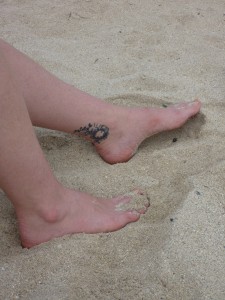I have a Harlot tattoo. Yup. That fancy O from the logo? It’s on the inside of my left ankle. It is, nearly needless to say, awesome. I got it the day before my dissertation defense; it offered a great physical distraction from mental strain. It also felt good to literally mark the end of that era, the final, long-time-coming accomplishment of the degree — and it made sense to mark it with Harlot. The visibility of the tattoo, its placement where people would see it all the time, was something I struggled with. Not just because my mother hates it, but because it felt like a rather public statement.
I went to a cool talk at a conference recently, and one of the presenters–the delightful folklorist Martha Sims–was talking about the rhetoric of tattoos, particularly verbal ones. The most interesting part, for me, was that several of the people she’d interviewed said that they don’t think about their tattoos as having an audience other than themselves. Their choices are meaningful and in some cases private; the fact that many people will see and interpret these texts was not a significant contributor. So this got me thinking about my own.
I have another tattoo, one I got in my 20s, that has personal significance but is otherwise, as first tattoos will be, a bit silly. Thankfully, that one is on my lower back — which means it gets mocking names like “tramp stamp,” but it’s also conveniently out of sight almost all the time. (Thank god I aged out of those super-low-rise jeans.) So that’s like my personal tat, whereas the Harlot one is my public tat.
I’m not sure what it communicates, of course. For most viewers, it would just be some fancy black design, without significance itself — but significant in its presence alone. I am a person with a visible tattoo. Different audiences will see this differently: I might be the cool professor or the trying-too-hard-to-be-cool professor or the edgy junior faculty or the trite gen-x-er… or, as in reality, some combination of all. I like that people don’t know what it is, because they’re less likely to have an immediate response to the content (and I might get to tell them about Harlot). But inevitably, it will be read, as will my body and therefore me. This, I realize, is not particularly novel: our bodies are read as texts all day long, whether based on elements under our control or not…
Perhaps that’s what a tattoo communicates: that we’ve chosen to textualize our bodies, to have a say in what they say. Even if what they say is incomprehensible…? Even when we’re/they’re only talking to ourselves…? Even when others overhear and understand — or not?
I should do some research on this, but we have an issue to put out. So… what do you guys think?


I think I would like to quote you 😉 The private tat/public tat is certainly one way to look at these, and in the case of your first one, it may never be that public (we hope). Still, as far as the public one, its presence is significant, as you say, regardless of whether people know what it is (or care). It’s going to be read in some way. To complicate this–if we’ve chosen to textualize our bodies and what they say isn’t comprehensible to those reading us, where does that put us? Does it suggest the futility of language (just kidding, sort of), or does it become a marker of independence, isolation… my body and beliefs are mine and mine alone?
Thanks, Martha!
This raises the question I love to ask students: Does intention or interpretation determine “meaning”? If an audience interprets a text a certain way that the author didn’t necessary intend,,,does it matter? (The futility of communication in general?!) For me, there’s something about the responsibility of the audience, in such cases, to try to put themselves in “the authorial audience,” to try to read the way the author would have wanted us to. Whether or not that’s ever actually possible, at least it can prevent the dismissive or derisive knee-jerk reactions that sometimes happen when, for example, we see something like a Tweety Bird or Nike swoosh tattoo. I don’t think I can ever understand that, but the exercise of trying is valuable.
I’m not sure about the isolation, in part because tats are often conversation-starters. In some way, they invite people into the personal space of our bodies, even if we only let them so far before they get lost…
Love it!